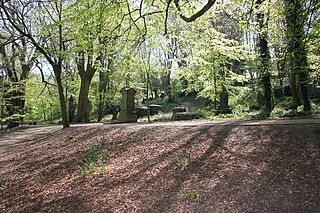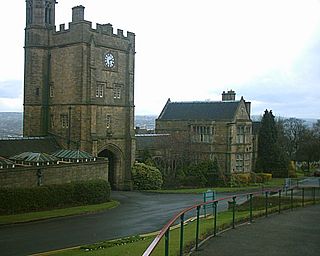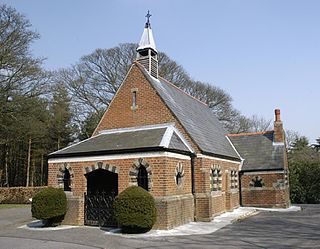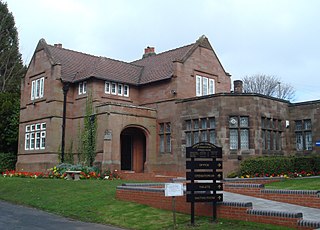
Brookwood Cemetery, also known as the London Necropolis, is a burial ground in Brookwood, Surrey, England. It is the largest cemetery in the United Kingdom and one of the largest in Europe. The cemetery is listed a Grade I site in the Register of Historic Parks and Gardens.

Anfield Cemetery, or the City of Liverpool Cemetery, is located in Anfield, a district of Liverpool, Merseyside, England. It lies to the northeast of Stanley Park, and is bounded by Walton Lane to the west, Priory Road to the south, a railway line to the north, and the gardens of houses on Ince Avenue to the east. The cemetery grounds are included in the National Register of Historic Parks and Gardens at Grade II*.

The General Cemetery in the City of Sheffield, England opened in 1836 and closed for burial in 1978. It was the principal cemetery in Victorian Sheffield with over 87,000 burials. Today it is a listed Landscape on the English Heritage National Register of Historic Parks and Gardens. It is also a Local Nature Reserve. It is owned by the City of Sheffield and managed on behalf of the city by a local community group, the Sheffield General Cemetery Trust.

Toxteth Park Cemetery is a graveyard on Smithdown Road, Liverpool, United Kingdom. It was opened on Monday 9 June 1856. It was the responsibility of the Toxteth Park Burial Board, which had been established by at least 1855.

York Cemetery is a cemetery located in the city of York, England. Founded in 1837, it now encompasses 24 acres and is owned and administered by The York Cemetery Trust with support of the Friends of York Cemetery. It is situated on Cemetery Road in the Fishergate area of York. It has approximately 28,000 graves and over 17,000 monuments, six of which are Grade II-listed. The chapel is a Grade II* listed building, while the gatehouse, gate and railings are Grade II. The architect of these buildings and the grounds was James Pigott Pritchett.

The City Road Cemetery is a cemetery in the City of Sheffield, England that opened in May 1881 and was originally Intake Road Cemetery. Covering 100 acres (40 ha) it is the largest and is the head office for all the municipally owned cemeteries in Sheffield. The cemetery contains Sheffield Crematorium, whose first cremation was on 24 April 1905.
James Pigott Pritchett was an English architect. He lived in London and York and his practice stretched from Lincolnshire to the Scottish borders.

Aldershot Military Cemetery is a burial ground for military personnel, or ex-military personnel and their families, located in Aldershot Military Town, Hampshire.

Lodge Hill Cemetery is a municipal cemetery and crematorium in Selly Oak, Birmingham, England. The cemetery was first opened by King’s Norton Rural District Council in 1895, and during the 1930s became the site of Birmingham's first municipal crematorium.

Brockley and Ladywell Cemeteries were opened within one month of each other in 1858 and are sited on adjacent plots of previously open land. The two component parts are characteristic examples of the first wave of Victorian public cemeteries and are now part of the Brockley Conservation Area.

Southern Cemetery is a large municipal cemetery in Chorlton-cum-Hardy, Manchester, England, 3 miles (4.8 km) south of the city centre. It opened in 1879 and is owned and administered by Manchester City Council. It is the largest municipal cemetery in the United Kingdom and the second largest in Europe.

Hamilton Road Cemetery is a combined municipal and military burial ground situated in the coastal town of Deal, Kent, in South East England. Opened in May 1856, it was created to provide a new burial ground for Deal at a time when its general population was expanding and when previous, often ad hoc facilities for dealing with deaths in the area no longer sufficed.

Reading Old Cemetery is in the east of Reading, Berkshire, England. It is located immediately to the east of Cemetery Junction, a major road junction in Reading. The cemetery is Grade II listed.

The two Camberwell cemeteries are close to one another in Honor Oak, south London, England. Both have noteworthy burials and architecture, and they are an important source of socioeconomic data in recording the historical growth and changing demography in the community for the Southwark area since 1855.

London Road Cemetery is a 17-hectare (42-acre) cemetery in Coventry, England, designed by Joseph Paxton and opened in 1847.

Tottenham Cemetery is a large burial ground in Tottenham in the London Borough of Haringey, in north London, England. It was opened in 1858 by the Tottenham Burial Board to replace the churchyard of All Hallows' Church, Tottenham which had closed the previous year. The original five-acre site was not entirely consecrated, with two acres designated for non-Church of England burials.

Earlham Road Cemetery, Norwich also known as Earlham Cemetery or Norwich Cemetery is a cemetery located in Norwich which was officially opened on 6 March 1856 and covers 34 acres (14 ha). The cemetery is divided into two distinct sites by Farrow Road A140 which runs north–south across the site. To the east of the road is the original 19th century cemetery and to the west of the road lies the 20th century addition. Today, it caters for all faiths with separate burial grounds and chapels for Jews and Catholics and a growing one for Muslims together with two military cemeteries. The 19th century cemetery is designed with an informal garden cemetery layout with winding paths while the remainder is a more formal grid type which was favoured by cemetery designer John Claudius Loudon. Much of the original cemetery is a County Wildlife Site and contains grassland and a wide selection of mature trees.
Major Walter George Burnett Dickinson FRSE FRCVS TD was a British veterinary surgeon, and one of the first "victims" of the First World War. He did not die in battle, but of a heart attack in Lincolnshire, but nevertheless officially became the first Major and second officer to die during the war.

Hollybrook Cemetery is a cemetery in Bassett, Southampton, England, containing around 53,000 graves as of August 2012 and still open to new burials as of March 2016. It is one of the main cemeteries in Southampton.

James Pigott Pritchett, known as J P Pritchett junior or J P Pritchett of Darlington, was a British architect.



















